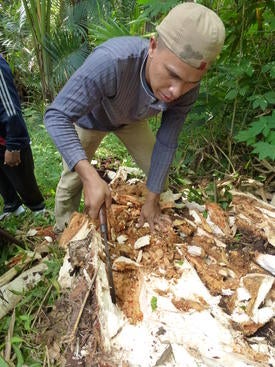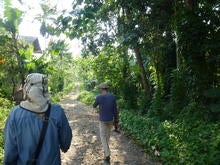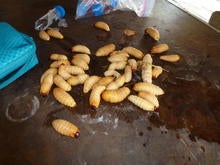Entomophagy: Collecting and Eating Red Palm Weevil Larvae from Nipa Palms in Sumatra, Indonesia
Palm Weevil. Photo by Mark Hoddle
The red stripe form of red palm weevil (referred to here as Rhynchophorus vulneratus) is harvested for food from nipa palm trunks in parts of Sumatra by rural and semi-rural agrarians. Nipa palms (Nypah fruticans; known as buah atap in Indonesia) typically grow in swampy muddy areas (in either fresh or brackish water conditions) and the fronds are used as thatch roofing, or basket making. Most of the trunk of the nipa palm grows underground and the leaves and flower stalks grow above ground. The sap and flowers are sweet, rich in sugars, and can be fermented. The trunk is high in starch and can be harvested, pounded, and dried to form a type of sweet “sago” flour.
Another use of the palm is for the deliberate rearing of R. vulneratuslarvae for harvesting and eating. Adult weevils are attracted to exposed damaged trunks and in some instances salt may be applied to the cut area which reportedly increases the attractiveness to breeding weevils. Adult weevils attracted to the palm trunk release an aggregation pheromone which further amplifies the attractiveness of the palm for breeding and feeding. Female weevils use their long rostrum or snout to chew holes into the trunk and eggs are laid (oviposited) into these holes. After several days, the eggs hatch and the small first instar weevil larvae burrow into the trunk to feed.
Palm trunks prepared for weevil attack are opened with an axe and machete after about six weeks. If the trunk is infested with weevil larvae a distinctive fermenting odor emanates from the trunk when it is opened, the internal tissue has oxidized and taken on a brownish color with interspersed ginger-colored gelatinous globs. This fed upon and fermenting material has the consistency of sloppy oatmeal (porridge). Weevil larvae feeding inside the palm trunk are easy to find because they make large diameter tunnels, and disturbance and probing of tunnels causes the legless larvae to wriggle vigorously and once they start to move they are easy to pick out of the tunnels.
The larvae are very high in protein and are considered by FAO to be an insect food that has potential to be commercialized because it requires low inputs for the quantity and quality of nutrition provided. About 1,700 species of insects are eaten by humans, mainly in the tropics because they are available year round, diversity is high, and the harvest and sale of insects for human food is a good income supplement. Human consumption of insects is called entomophagy.
Large R. vulneratus larvae harvested from nipa logs in Sumatra can sell for as much as 1000 rupiah (~ $0.11 US) each while smaller larvae fetch around 500 rupiah. Larvae can be cooked before being eaten. To prepare larvae, the large head capsule is removed, larvae may be blanched quickly in boiling water before being battered and deep fried or prepared as a type of curry. When prepared this way weevil larvae are reminiscent of cooked shrimp or squid. Another selling point for these larvae is their apparent potency as an aphrodisiac (something I can’t confirm or deny after eating many). One of our field assistants refused to eat the larvae because he was working away from his village and wouldn’t see his wife for the next two weeks. This may be a powerful testimony to the power of this aphrodisiac.
Alternatively, larvae can be eaten raw straight from the nipa trunk. Smaller larvae are preferred because they are easier to chew and swallow. However, large larvae are no problem to eat alive. The best way to eat palm weevil larvae raw is to hold them by the head capsule between your thumb and forefinger, place the larva’s body in your mouth, and bite behind the head severing it from the body and leaving the head capsule between your fingertips. Palm weevil larvae from nipa palms are surprisingly sweet, the texture internal body contents is smooth and agreeable, and they don’t have a foul or weird taste (you’d expect them to taste like rotting wood but they don’t!) The larva cuticle or skin is very chewy and can be spat out or easily swallowed.
I was very surprised at how easy these larvae were to eat straight from the nipa palm trunk in the jungle. We washed the larvae with some drinking water to remove the fermenting palm mush prior to eating them. Our guides indicated that the most preferred weevil larvae are taken from nipa palms while those harvested from the crowns of coconuts have a less agreeable taste and texture.
|
|
|
|
|
|
For more info:
Red Palm Weevil on CISR
Edible Forest Insects – Humans Bite Back!!
Beastly Bugs or Edible Delicacies?
Time for a ‘Bug Mac’? The Dutch Aim to Make Insects More Palatable
Entomophagy: Edible forest insects
Could you please pass me the bug kabobs?





